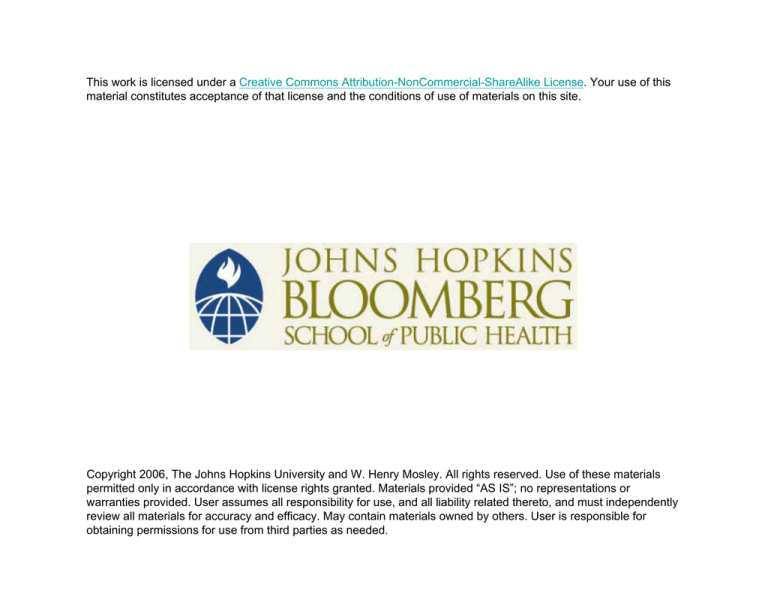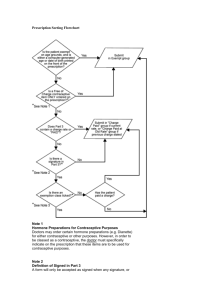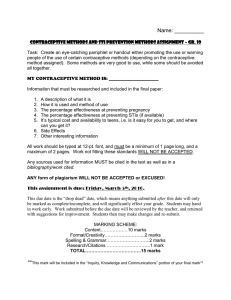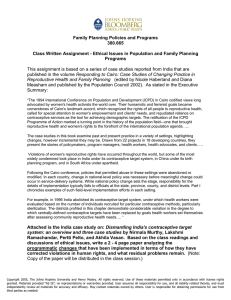
This work is licensed under a Creative Commons Attribution-NonCommercial-ShareAlike License. Your use of this
material constitutes acceptance of that license and the conditions of use of materials on this site.
Copyright 2006, The Johns Hopkins University and W. Henry Mosley. All rights reserved. Use of these materials
permitted only in accordance with license rights granted. Materials provided “AS IS”; no representations or
warranties provided. User assumes all responsibility for use, and all liability related thereto, and must independently
review all materials for accuracy and efficacy. May contain materials owned by others. User is responsible for
obtaining permissions for use from third parties as needed.
Paying for Family Planning
Costs, Cost Recovery, and
Cost-effective Investment
Strategies
Family Planning Policies and
Programs
W. Henry Mosley
Essential Definitions
• Costs versus Prices
• Cost-benefit versus Costeffectiveness
Why Subsidize Family Planning
Services?
• Fertility control has social benefits as well
as individual benefits
• Individual demand for family planning
services is constrained by resources
(material and non-material)
• Free markets cannot meet social welfare
objectives
What has been the historical pattern
of public sector contraceptive
pricing and subsidies?
See the following slides.
What is the experience with
social marketing?
• Definition: the design,
implementation, and control of
programs calculated to influence
the acceptability of a social idea
and involving considerations of
product planning, pricing,
communications, distribution, and
market research.
Social Marketing
• 1. Contraceptive social
marketing:
a. uses existing commercial/retail channels
b. subsidizes prices and recovers partial
costs to:
- achieve high distribution
- reach low income groups
Social Marketing Issues
• 1. Management must fit local
circumstances(examples of managers)
• - family planning organizations
• - private sector organizations established
specifically for CSM
• - quasi-governmental agencies
• - government agencies
Social Marketing Issues
• 2. Potential customers
– - market segmentation
• 3. Products
– - condoms, orals, spermicides, IUDs, injectables
• 4. Pricing
– - a balance between assuring wide availability, retailer
profitability and cost recovery
• 5. Promotion
– - promote products (brands) and providers
– - target promotion to consumers and providers
– - continuous promotion
Social Marketing Issues
• 6. Evaluation measures
– - sales
– - couple-year-of-protection (CYP)
- coverage
- cost/CYP
What Are the Financial Issues of
Concern?
• Program sustainability in the presence of:
–
–
–
–
Rapidly growing demand for contraception
Diminishing donor support
Constrained national budgets
Competing priorities
• Demand for program accountability
– Growing interest in “evidence-based” decision
making
– Need for performance improvement indicators
Case Study
Impact of Contraceptive Social Marketing
(CSM) on Contraceptive Prevalence and
Cost in Honduras by Janowitz, et al., SFP 1992: 2,
pp 110-117.
Key point: Introducing CSM may not make an
NGO program more efficient if:
– Community-based distribution (CBD) users
switch to CSM but CBD program still expands
– Private sector users switch to CSM
What are the user costs?
• Search costs for information
•
•
•
•
•
•
Time costs
Method variety costs (not getting choice)
Administrative costs
Social/cultural costs
Health and psychic costs
Monetary costs
The Client’s Perspective:
Getting to the Door
(Source: http://www.maqweb.org)
The Client’s Perspective:
Inside the Door
(Source: http://www.maqweb.org)
What is the Elasticity of Demand to
Price Change?
• Definition: The price elasticity of demand for a
good is the proportional change in the quantity
demanded of the good relative to the proportional
change in the price.
•
Example: Matheny (2004) cites 5 studies of
the overall price elasticity of demand for
contraceptives which showed elasticities in the
range of 0 to 0.15. That is, for every 100%
increase in the mean price of contraceptives, the
contraceptive use decreased by 0% to 15%.
Elasticity of Contraceptive
Demand to Price Changes
• Sources of variation:
– Type of contraceptive
– Initial price vs. cumulative costs
– The role of substitutes
– Non-monetary costs
– Economic situation
– Perceptions of value
Key Points Regarding
Contraceptive Costs and Prices
1. Costs of service delivery vary widely:
a) across countries
b) by program strategy within countries
2. Prices to consumers for services vary widely
from very high to negative (subsidies).
3. Consumer uptake of services is price sensitive,
but has never been systematically studied.
Key Points Regarding
Contraceptive Costs and Prices
4. Empirical observations of price elasticity
indicate that:
a) As prices go up
-
overall uptake may go down, but elasticity is
sensitive to many external factors
poorer consumers may drop out with high prices
b) Negative prices (subsidies) are an inducement
to poor consumers (What are the ethical issues?)
What is cost-effectiveness of alternative
strategies to promote contraceptive use?
• The low elasticities of contraceptive demand with
contraceptive price subsidies (as summarized
above) lead to an estimate of $61 per couple year
of protection in Indonesia, if investments are just
made in price subsidies.
• Media campaigns in Egypt, Turkey, and
Zimbabwe have given estimates of $3.26, $1.36
and $3.57 per CYP.
• Strategies to improve quality appear to be very
cost-effective, but good empirical data are lacking.
Ref. Matheny, 2004
Conclusion
Programs should conduct marketing research
to identify local barriers to contraceptive
use and determine the most cost-effective
ways to lower these barriers.
The Keys to Program Sustainability
(Resource Allocation, Not Cost-Recovery)
1. Cost-benefit analyses to compete for funds across
all development sectors in national budgets.
2. Cost-effectiveness analyses to compete for funds
among alternative health sector investments in
MOH budgets (e.g., using DALYs).
3. Cost-effectiveness analyses within the FP program
to best allocate funds among alternative service
delivery program strategies (e.g., using CYP)
4. Cost-accounting analyses in every service delivery
program to maximize efficiencies.







